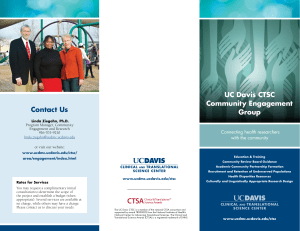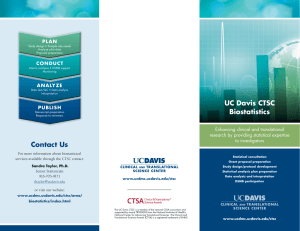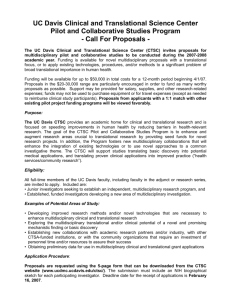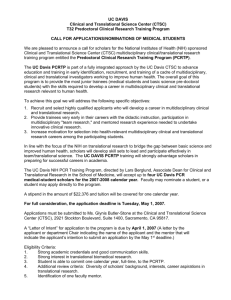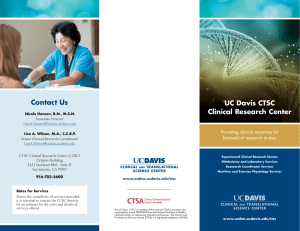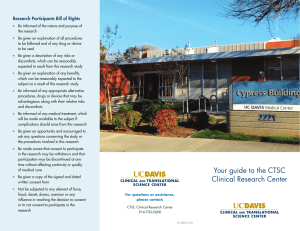Glimmers of hope in autism research
advertisement
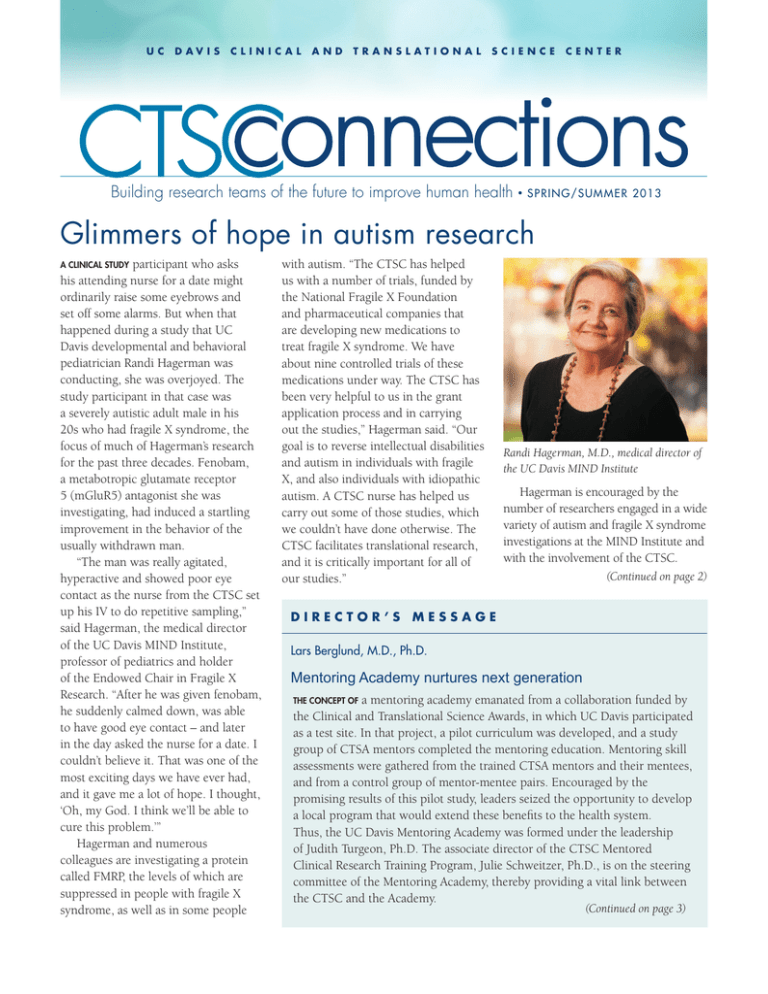
UC D av i s Clinical and Translational Sc i e n c e Center Building research teams of the future to improve human health • SP RING /SUM M ER 2013 Glimmers of hope in autism research A clinical study participant who asks his attending nurse for a date might ordinarily raise some eyebrows and set off some alarms. But when that happened during a study that UC Davis developmental and behavioral pediatrician Randi Hagerman was conducting, she was overjoyed. The study participant in that case was a severely autistic adult male in his 20s who had fragile X syndrome, the focus of much of Hagerman’s research for the past three decades. Fenobam, a metabotropic glutamate receptor 5 (mGluR5) antagonist she was investigating, had induced a startling improvement in the behavior of the usually withdrawn man. “The man was really agitated, hyperactive and showed poor eye contact as the nurse from the CTSC set up his IV to do repetitive sampling,” said Hagerman, the medical director of the UC Davis MIND Institute, professor of pediatrics and holder of the Endowed Chair in Fragile X Research. “After he was given fenobam, he suddenly calmed down, was able to have good eye contact – and later in the day asked the nurse for a date. I couldn’t believe it. That was one of the most exciting days we have ever had, and it gave me a lot of hope. I thought, ‘Oh, my God. I think we’ll be able to cure this problem.’” Hagerman and numerous colleagues are investigating a protein called FMRP, the levels of which are suppressed in people with fragile X syndrome, as well as in some people with autism. “The CTSC has helped us with a number of trials, funded by the National Fragile X Foundation and pharmaceutical companies that are developing new medications to treat fragile X syndrome. We have about nine controlled trials of these medications under way. The CTSC has been very helpful to us in the grant application process and in carrying out the studies,” Hagerman said. “Our goal is to reverse intellectual disabilities and autism in individuals with fragile X, and also individuals with idiopathic autism. A CTSC nurse has helped us carry out some of those studies, which we couldn’t have done otherwise. The CTSC facilitates translational research, and it is critically important for all of our studies.” Randi Hagerman, M.D., medical director of the UC Davis MIND Institute Hagerman is encouraged by the number of researchers engaged in a wide variety of autism and fragile X syndrome investigations at the MIND Institute and with the involvement of the CTSC. (Continued on page 2) D IRE C T OR ’ S M ESSA G E Lars Berglund, M.D., Ph.D. Mentoring Academy nurtures next generation a mentoring academy emanated from a collaboration funded by the Clinical and Translational Science Awards, in which UC Davis participated as a test site. In that project, a pilot curriculum was developed, and a study group of CTSA mentors completed the mentoring education. Mentoring skill assessments were gathered from the trained CTSA mentors and their mentees, and from a control group of mentor-mentee pairs. Encouraged by the promising results of this pilot study, leaders seized the opportunity to develop a local program that would extend these benefits to the health system. Thus, the UC Davis Mentoring Academy was formed under the leadership of Judith Turgeon, Ph.D. The associate director of the CTSC Mentored Clinical Research Training Program, Julie Schweitzer, Ph.D., is on the steering committee of the Mentoring Academy, thereby providing a vital link between the CTSC and the Academy. (Continued on page 3) The concept of Autism research Continued from page 1 “Flora Tassone at the MIND Institute developed a blood spot test, enabling newborn screening for fragile X during the past four years under an NIH grant,” Hagerman said. “David Hessl on our team is conducting a study using computing to enhance attention and concentration problems in individuals with fragile X syndrome. We’re looking at iPad applications in a study by Maria Diez for children with autism or fragile X syndrome, and we’re conducting a literacy study. Kerrie Lemons-Chitwood is looking at reading interventions for individuals with fragile X syndrome,” she continued, running out of fingers as she counted the many projects under way. “Len Abbeduto, the new director of the MIND Institute, has conducted a language-intervention study, exploring how individuals with fragile X syndrome learn language in comparison to individuals with idiopathic autism. He also has a new study looking at transitions into adulthood.” UC Davis researchers investigating autism also include Irva HertzPicciotto, a professor in the Department of Public Health Sciences and chief of its Division of Environmental and Occupational Health. HertzPicciotto (pronounced pih-CHOH-toe) investigates environmental factors such as air pollution, pesticides and nutrition, which may increase or decrease the risk that a child develops autism or other neurodevelopmental delays. She oversees or participates in three large ongoing studies in which the CTSC plays a significant role. The CHARGE (CHildhood Autism Risks from Genetics and the Environment) study, which Hertz-Picciotto inaugurated in 2003, is a comprehensive, population-based study of genetic as well as non-inherited factors that contribute to autism and developmental delays. In 2006, she launched 2 the MARBLES (Markers of Autism Risk in Babies – Learning Early Signs) study, the first to examine early environmental and biologic predictors of autism, beginning, during and before pregnancy. In 2009, she became a collaborator in the EARLI (Early Autism Risk Longitudinal Investigation) study, encompassing a network of multiple institutions where investigation of risk factors for autism spectrum disorders is under way. “We’ve worked with the CTSC on the CHARGE study, but it has been extremely helpful to us with the MARBLES study,” said Hertz-Picciotto, deputy director of the UC Davis Center for Children’s Environmental Health and director of the Program in Environmental Epidemiology of Autism at the MIND Institute. “Participants in the MARBLES study are women who have a child with autism and are pregnant with another child. We needed to collect information about the home environment as well as numerous blood samples during the pregnancy and then later from the child. To make this protocol as convenient as possible for families, we wanted to schedule (Continued on page 3) On the road with a CTSC phlebotomist Mary Tofflemire’s day planner reads like a travelogue of Northern and Central California locales. She’s a certified phlebotomy technician who spends far more time on the road than she does at the CTSC Clinical Research Center (CCRC) facility. Tofflemire, typically accompanied by a clinician or a research coordinator, journeys in a Toyota Prius nicknamed “Patty” to draw blood samples in the homes of participants in MARBLES (Markers of Autism Risk in Babies – Learning Early Signs) and other research studies. The team also meets study participants at the MIND Institute. On a Monday, Tofflemire might drive to Gilroy. If it’s Tuesday, she must be in Modesto. She heads to San Leandro on Wednesday, and Modesto on Thursday. On a Friday she might be in Half Moon Bay. No matter where she has traveled, she must drive back to the CCRC at day’s end to process the samples she has collected. Tofflemire is prepared to calm patients who might scream, cry and wiggle. Her tools for blood draws include the “papoose,” a board with canvas wrapping that some children with autism find comforting. At a home visit, a study coordinator may vacuum – not to clean, but to collect dust samples as part of an environmental assay. “When we arrive at subjects’ homes, it looks like we’re a cleaning crew. We unload vacuums and containers, and I have my little pull cart that I use to carry all of my equipment,” Tofflemire said. “We follow a specific protocol for each visit to ensure that it’s done exactly the same way every time.” “Mary has an uncanny ability to quickly connect with patients and their families, building genuine rapport and trust early in the visit,” reports Nicole Hansen, associate director of the CCRC. “Our study participants often lead challenging lives, and providing them with a phlebotomist who is able to help alleviate their stress is an asset for them as well as for our investigators.” The CCRC team’s home visits are crucial to ensuring that busy families can participate in state-of-the-art research on a wide range of disorders, from autism to multiple sclerosis. UC Davis Clinical and Translational Science Center • Spring/Summer 2013 Autism research Continued from page 2 home visits rather than requiring them to come into the clinic. Because we needed assistance, I contacted the CTSC at the very beginning.” The CTSC assigned staff phlebotomist Mary Tofflemire to travel with coordinators to the homes of participants throughout Northern California (as the accompanying article describes). “Because they already have another child with serious developmental problems, many of these mothers who are pregnant or have recently given birth are very stressed. So the CTSC’s home visit services have been enormously beneficial, a major contribution to the study,” HertzPicciotto said. She also credits the CTSC with helping her retain postdoctoral researcher Rebecca Schmidt, a participant in an autism research training program at the MIND Institute. “When she finished her postdoctoral fellowship, the Building Interdisciplinary Research Careers in Women’s Health (BIRCWH) scholars program, administered through the CTSC, provided her with funding to MARBLES study director Irva Hertz-Picciotto, Ph.D., M.P.H., with a 6-month old participant (photo by Jose Villegas) launch her career,” Hertz-Picciotto said. Schmidt has been engaged in pioneering studies of relationships between folic acid and autism. The cross-disciplinary infrastructure of the CTSC is especially important to Hertz-Picciotto. “Our studies have involved a number of people who are characterizing a great many features of immunologic disregulation in children with autism. That work has opened up another whole area of inquiry for me about how the immune system and the brain depend on each other for development,” Hertz-Picciotto said. “I might never have done that if the CTSC had not put me in touch with these other scientists.” D IRE C T OR ’ S M ESSA G E c o n t i n u e d f r o m p a g e 1 Lars Berglund, M.D., Ph.D. Mentors and curriculum focus on developing essential skills to improve research, clinical teaching and leadership. The Academy offers five core modules, which include both didactic and case-based exchanges, as well as specialty workshops that provide more in-depth experiences on a variety of topics, including cultural competencies and methods to give effective feedback. The Mentoring Academy serves as a resource for mentors, helps coordinate oversight for the mentoring process, conducts UC Davis Clinical and Translational Science Center • Spring/Summer 2013 training for mentors, develops goals and incentives for participants, and evaluates the effectiveness of the mentoring program. I congratulate Dr. Turgeon and her team members for transforming the Mentoring Academy from plan to reality, and look forward to the growing cadre of faculty mentors who can serve the community to advance research and nurture the next generation of biomedical scientists. Please visit www.ucdmc.ucdavis. edu/mentoring to learn more. 3 D e a n o f B i o l o g i c a l Sc i e n c e s d e v e l o p s H IV th e r a p y Hildreth clinical trial leverages CTSC resources James Hildreth, dean of the UC Davis College of Biological Sciences, believes that the advancement of translational science could be accelerated by individuals who are knowledgeable in the methods and approaches of both basic sciences and applied disciplines. This is probably true for translational biology in general and translational medicine in particular. He already has plans for a program based on this concept. “Postdoctoral fellows could be co-mentored by a clinical scientist and a basic scientist under what I call ‘bridging fellowships.’ That dual relationship would help drive the translational process of mobilizing observations made at the bench into meaningful interventions for people with disease. We need to think creatively about new models,” said Hildreth, whose own focused observation and creative thinking throughout the past 30 years have increased understanding of the mechanisms of HIV and AIDS. His discoveries have earned him numerous accolades, notably the 2011 NIH Director’s Pioneer Award. But Hildreth might not have pursued that career path had it not been for two patients he encountered in 1985 when he was a third-year Johns Hopkins University medical student. At that time, he had an interest in immunology research and was intent on becoming a transplant surgeon. “As part of my rotation experience, I took care of a young woman who had just given birth to a baby. Both she and the baby turned out to be HIVpositive. That had a profound effect on my thinking,” Hildreth said. When he later became a faculty member at Johns Hopkins, his department chair persuaded him to establish an HIV research program focused 4 on preventing transmission of the infection. Before joining UC Davis in August 2011, Hildreth was the director of the translational research center at Meharry Medical College in Tennessee, where he led a research team examining the biological basis for health disparities in HIV/AIDS. In 2001, while Hildreth was still at Johns Hopkins, he and James Hildreth, Ph.D., M.D., dean of the UC Davis College of Biological Sciences his research team discovered the role of cholesterol in HIV infection. He has since been developing a vaginal microbicide containing betacyclodextrin, a cyclic polymer of glucose that removes cholesterol from cellular membranes, as a means to block infection. He is preparing to conduct a phase 1 trial in Atlanta and at UC Davis to study this same compound as a new approach to treat HIV infections. “Our colleagues at the UC Davis CTSC will be helping us with that study,” said Hildreth, who has academic appointments in the UC Davis departments of Internal Medicine and Molecular and Cellular Biology. “The CTSC staff has been very helpful in assisting us with preparation of the investigational new drug application to the Food and Drug Administration, and they will be an integral part of the study once it begins.” The research is a response to a disturbing disparity. “Globally, twothirds of the people who are infected by HIV are of African descent. Of 34 million people infected or living with HIV worldwide, 22 million live in the southern half of the African continent. Here in the United States, African Americans make up only 13 percent of the total population, but almost half of the individuals living with HIV are African American,” Hildreth said. “Social, cultural, perhaps even political factors have contributed to the disparity in the United States.” The evolutionary path of Hildreth’s research has made him a strong advocate of basic research. “A lot of the most spectacular treatments we have for diseases are the result of knowledge gained from individuals conducting basic research. That’s why I’m excited about interfacing the basic science research we’re doing in the College of Biological Sciences with individuals who do more applied or translational work,” Hildreth said. “The CTSC has a very important role to play in the process of shaping basic discoveries into clinical applications, and having one on our campus is a tremendous asset for UC Davis.” Hildreth obtained his bachelor’s degree from Harvard University, where he graduated magna cum laude in chemistry in 1979. He was a Rhodes scholar at Oxford University in England, where he earned his Ph.D. in immunology in 1982. UC Davis Clinical and Translational Science Center • Spring/Summer 2013 F e a tu r e d s ch o l a r Samantha McDonnel exemplifies translational science Curiosity may have killed the cat, but former CTSC T32 scholar Samantha McDonnel’s insatiable curiosity may very well save the lives of countless felines as well as human beings. “Curiosity will always get the best of me, but in science that’s a good thing,” quips McDonnel, a veterinary medicine and doctoral student in the Comparative Pathology Graduate Group at UC Davis who has always been interested in virology, especially in the use of retroviruses as vectors for gene therapy. McDonnel is immersed in the study of feline immunodeficiency virus (FIV), an important animal model of human immunodeficiency virus (HIV). Working with mentor Brian Murphy, a veterinary pathologist at the School of Veterinary Medicine, McDonnel hopes to gain a better understanding of the mechanisms of retroviral latency and potential ways to disarm the infection in cats. “FIV and latency is a very cool problem to work on,” McDonnel said. “It is a valuable model for HIV persistence – an extremely important challenge in human health. Information we gain from animal research could be fasttracked to better understand the disease in humans. We hope that research using the feline AIDS model will benefit humans and cats alike.” With regard to the training she received through the CTSC, McDonnel adds, “The T32 training program allowed me to visualize how research like mine might really move forward one day to benefit the lives of people and animals. That has always been the goal, of course, but now it seems much more tangible, like ‘translational science’ is more than just a thought exercise.” McDonnel also credits the training program for helping her connect with colleagues in human medicine, especially those involved in clinical trials. McDonnel has attracted the attention of at least one notable colleague in human medicine, Nicholas Kenyon, director of the T32 Predoctoral Training Program. Kenyon believes that McDonnel is particularly skilled at describing her work and its potential translational relevance. “Samantha’s research presentations locally and at our national CTSC T32 meeting at the Mayo Clinic were simply outstanding,” Kenyon said. Visit https://www.facebook.com/UcDavisClinicalAndTranslationalScienceCenter to view a video about Samantha McDonnel’s research and scholar experience. A p a th t o r e s e a r ch th r o ugh th e M C R T P CTSC legacy of education Shortly after emergency medicine physician Aaron Bair began his academic career, he recognized that something important was missing. His medical education did not sufficiently prepare him to pursue research. The same insight struck pediatrician Ulfat Shaikh and veterinary radiation oncologist Michael Kent. “When I was a junior faculty member in the Clinical X series, it became readily apparent that little of what I had been exposed to up until that time prepared me for a career in research,” said Bair, an associate professor of emergency medicine and medical director of the Center for Health and Technology and the Center for Virtual Care. “There was no dedicated time in either medical school or residency to appreciate the research environment or develop skills in grant writing and grant funding mechanisms.” In 2004, Bair learned of the newly established K30 program – which evolved into the CTSC Mentored Clinical Research Training Program (MCRTP). He enrolled, completing the course of study with the inaugural class in 2006. UC Davis Clinical and Translational Science Center • Spring/Summer 2013 “The MCRTP curriculum turned out to be particularly relevant in my circumstance because my mentor went on to be my department chair, and we have had multiple opportunities for collaboration. The mentor-mentee relationship has evolved and continued in ways that have been very useful in the development of my career,” said Bair, who embraced the MCRTP after realizing that a master of public health degree would not help him achieve his goals. “The MCRTP allowed me to customize a training program with (Continued on page 6) 5 CTSC legacy Continued from page 5 a specific set of skills. Through the program, I could focus on developing my electives and research project, without having to spend a lot of time on a core curriculum that wasn’t as relevant to my particular goals.” Bair applauds the flexibility of the MCRTP curriculum in adapting to the training needs of participants. “The MCRTP is a fantastic program. It certainly opened doors for me, and has helped inform my career path.” “The MCRTP is a fantastic program. It certainly opened doors for me, and has helped inform my career path.” – Aaron Bair Ulfat Shaikh, an associate professor of pediatrics and director of health care quality, is the principal investigator on a multi-campus project funded with a grant from the UC Center for Health Quality and Innovation. She attributes her involvement in that and other research projects to training she received in the two-year MCRTP program beginning in 2005. While working exclusively in patient care at another institution, she had observed wide variations in standards of care that she thought deserved exploration. She tried conducting a study independently, but became frustrated. “I had reached the limits of what I could do on my own without training to make more high-impact changes,” Shaikh said. She joined UC Davis because it offered protected time to conduct research, but she was initially uncertain on how to proceed. “Because I was interested in evaluating patient-care delivery and clinician practice patterns, my UC Davis department chair encouraged me to submit 6 an application to MCRTP,” Shaikh said. She enrolled with three main learning goals: how to conduct a rigorous study, how to prepare journal articles, and how to write competitive grant applications. She said the knowledge that she gained in MCRTP helped her receive a K12 training award and a K08 career development grant – both of which ultimately contributed to her success as a researcher. “Through the MCRTP, I received training in grant writing and how to develop an effective scientific theme and involve collaborators from diverse backgrounds,” she said. “My MCRTP advisers and mentors helped me write these grants, working very closely with me to strengthen them and make them more competitive. One of my mentors in the CTSC was one of my collaborators on the UC Health Quality Improvement Network grant.” Funded in 2011, Shaikh is principal investigator on this project and is developing an infrastructure aimed at improving patient care transitions during hospital discharge. Michael Kent, an associate professor in the School of Veterinary Medicine’s Department of Surgical and Radiological Sciences, enrolled in the MCRTP’s inaugural session to strengthen his research skills and broaden his clinical research training. “Back in 2004, the concept of translational medicine was new, and I was intrigued by the program and the idea of team science with an interdisciplinary focus. Being a veterinarian, I saw it as an opportunity to learn how to promote the concept of One Health, and promote human health as well,” said Kent, who codirects the Comparative Cancer Center and is the associate director of the Center for Companion Animal Health. MCRTP not only advanced Kent’s knowledge but also helped him establish important and enduring relationships with other researchers in veterinary and human medicine. “My MCRTP involvement led to collaborations throughout the past 10 years with faculty members from various departments outside my own,” Kent said. The MCRTP curriculum also broadened his understanding of how to structure a formal mentorship, which led him to take on this role in his department, through which he helps guide the careers of new faculty members. The interdisciplinary research training that Bair, Kent, Shaikh and other scholars received through the MCRTP is a fundamental component of the CTSC’s mission to build research teams of the future. Ulfat Shaikh, M.D., M.P.H., with a pediatric patient and the child’s parent UC Davis Clinical and Translational Science Center • Spring/Summer 2013 n e w a p p o i n tm e n t Diercks named Regulatory Knowledge and Support director in medicine and research, Deborah B. Diercks, M.D., M.Sc., brings a wealth of knowledge and experience to her new role as director of the CTSC Regulatory Knowledge and Support program. In this position, she is responsible for interpreting and integrating regulations that guide clinical research and supporting the CTSC’s overall charge to advance medicine through collaborative research to improve human health. Diercks, now a professor of emergency medicine and member of the UC Davis Institutional Review Board, also is a national leader in clinical research. She was introduced to research methodology as a medical student though the study of medical records to better understand the impact of delayed diagnosis of breast cancer. As a resident, she continued With a broad resume her research career by studying the management and diagnosis of acute cardiovascular emergencies, and received additional training in her specialty area. As a third- and fourth-year resident she started looking into treadmill use for evaluation of low-risk patients and continued her work in this domain. She also serves as a School of Medicine representative to the Western Emergency Services Translational Research Network (WESTRN), a regional consortium of leaders in emergency medicine who train the next generation of clinical investigators in emergency care. This group was established through collaboration among all western state emergency medicine programs located at sites that have received a Clinical and Translational Science Award (CTSA). WESTRN has established a pool of investigators for multi-centered trials and has been a huge benefit to emergency medicine research. She is now dedicated to clinical practice and teaching. Her passion for training young physicians is rewarded by seeing them mature into independent researchers who conduct high-impact studies that advance human health. CTSC training programs break down barriers curriculum has matured substantially since its inception in the early 2000s. Program integration and development of team science, advanced grant writing, focused training in translational research, and other curriculum components have greatly strengthened the MCRTP as the complement of CTSC training programs has expanded. All of the programs are oriented toward interdisciplinary research, according to Jennifer Greenier, manager of CTSC Research Education and Training. “Each of our scholars is pursuing translational research focused on advancing health,” Greenier said. “Our approach is to bring together scholars from divergent research backgrounds The fledgling MCRTP with diverse skill sets and areas of expertise, and to create an environment in which they work together on course projects, constructively critique each other’s research, and engage in discussions about topics pertaining to translational research, career development, and ethics. In that way, CTSC training programs break down barriers between the cultures of basic science, clinical research and community-based research.” CTSC training programs welcome not only health sciences faculty members but also medical students, clinical fellows, graduate students, and postdoctoral researchers from departments, disciplines, graduate groups, schools and colleges throughout UC Davis. UC Davis Clinical and Translational Science Center • Spring/Summer 2013 “Our scholars exhibit a tremendous amount of diversity in research interests, career stages, skill sets and perspectives,” Greenier said. “That’s an important aspect of our training programs, because bringing together people from such diverse backgrounds creates a natural environment for generating novel research hypotheses, interdisciplinary collaborations, and innovative solutions that might not occur within a homogenous group of trainees in a more insular environment.” CTSC training programs offer numerous other intangible benefits in the view of Julie Schweitzer, the CTSC’s Research Education and Training program co-director. (Continued on page 8) 7 Clinical and Translational Science Center 2921 Stockton Blvd., Suite 1400 Sacramento, CA 95817 Address service requested CTSC Training Programs Continued “Researchers can feel isolated when they are working on their own, but beyond structure and curriculum, CTSC programs offer camaraderie and opportunities to gain insights from colleagues about how to better balance time, find resources, work with mentors, and even navigate politics within science. You will be at a disadvantage if you are trying to make those discoveries on your own,” said Schweitzer, an associate professor of psychiatry and behavioral sciences. from page 7 “Participants in our programs find they have to learn to talk a common language that cuts across different disciplines. Developing these communication skills is important because it helps participants understand the relevance of their work to other areas that they might not have considered if they had been working only within their own discipline,” Schweitzer added. “That’s a vital role that the CTSC plays in helping transform academic scholars into the translational scientists of the future.” The Mentored Clinical Research Training Program (MCRTP) has the longest history of the numerous educational programs that the CTSC administers, all with the overarching goal of building research teams of the future. At http://ucdmc.ucdavis.edu/ctsc/area/ education/training_table.html you’ll find links to summary pages about the MCRTP and the other CTSC training programs: • Predoctoral Clinical Research Training Program (T32) • Mentored Career Development Program (K12) • UC Davis Cancer Center Paul Calabresi Career Development K12 Program (K12) • UC Davis Emergency Medicine Clinical Research Training Program (K12) • California Institute for Regenerative Medicine (CIRM) Stem Cell Training Program • Howard Hughes Medical Institute-funded Integrating Medicine into Basic Science Program • Building Interdisciplinary Research Careers in Women’s Health (BIRCWH) Program Find us on Facebook https://www.facebook.com/UcDavisClinicalAndTranslationalScienceCenter The UC Davis CTSC is a member of the national CTSA consortium and supported by award TR000002 from the National Institutes of Health’s National Center for Advancing Translational Sciences. CTSC Connections is published twice a year by the UC Davis Health System. To add your name to the mailing list, send an e-mail to CTSCMail@ucdmc.ucdavis.edu. http://www.ucdmc.ucdavis.edu/ctsc/ Executive Editor Lars Berglund Managing Editor Kitty Lombardo Creative Director Christine Hotz Editors Carole Gan Alice Tarantal Writing EditPros LLC The University of California does not discriminate on the basis of race, color, national origin, religion, sex, sexual orientation, disability, age, veterans’ status, medical condition, ancestry or marital status. The University of California is an affirmative action/equal opportunity employer. Call 530-752-2071 for more information. Speech or hearing-impaired persons may call 530-752-7320 (TDD).

